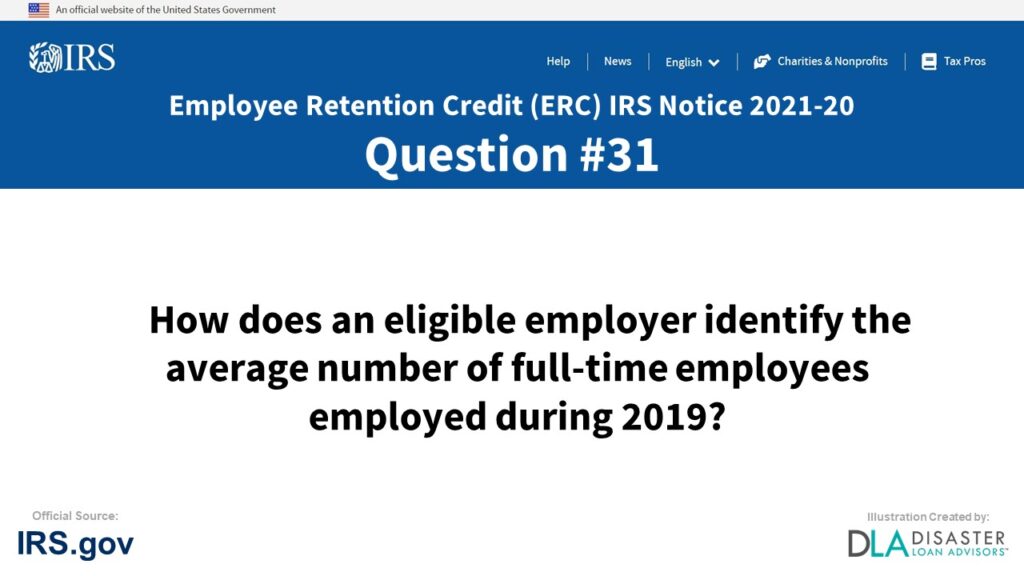
Question #31:
How does an eligible employer identify the average number of full-time employees employed during 2019?
Found under the G. Qualified Wages Section of the Employee Retention Credit (ERC) IRS Notice 2021-20 with updated guidance to help business owners follow the current ERC rules.
The answer to question #31, How does an eligible employer identify the average number of full-time employees employed during 2019?, can be found below.
ERC IRS Notice 2021-20 Question #31:
G. Qualified Wages
How does an eligible employer identify the average number of full-time employees employed during 2019?
The term “full-time employee” means an employee who, with respect to any calendar month in 2019, had an average of at least 30 hours of service per week or 130 hours of service in the month (130 hours of service in a month is treated as the monthly equivalent of at least 30 hours of service per week), as determined in accordance with section 4980H of the Code.
An employer that operated its business for the entire 2019 calendar year determines the number of its full-time employees by taking the sum of the number of full-time employees in each calendar month in 2019 and dividing that number by 12. An employer that started its business operations during 2019 determines the number of its full-time employees by taking the sum of the number of full-time employees in each full calendar month in 2019 in which the employer operated its business and dividing that sum by the number of full calendar months in 2019 in which the employer operated its business.
An employer that started its business operations during 2020 determines the number of its full-time employees by taking the sum of the number of full-time employees in each full calendar month in 2020 in which the employer operated its business and dividing by that number of months, consistent with the approach described above for employers that began business operations during 2019.
For more information about the Employee Retention Credit (ERC) IRS Notice 2021-20, visit the Internal Revenue Service (IRS) Department of the Treasury, official IRS.gov tax website.
Conclusion and Summary on How does an eligible employer identify the average number of full-time employees employed during 2019? – #31 ERC IRS Notice 2021-20
The answer to Question #31: “How does an eligible employer identify the average number of full-time employees employed during 2019?” was answered in detail above. It was found under section “G. Qualified Wages” in IRS Notice 2021-20.
Leave a comment below if you have further questions on the Employee Retention Credit (ERC) or for clarifications on How does an eligible employer identify the average number of full-time employees employed during 2019?
Employee Retention Tax Credit (ERTC): Expert Assistance to Claim Your Business ERC Credit
Up to a $26,000 ERC Refund from the IRS for Each Employee
Disaster Loan Advisors can assist your business with the complex and confusing Employee Retention Credit (ERC), Form 941-X, and the Employee Retention Tax Credit (ERTC) program.
Depending on eligibility, business owners and companies can receive up to $26,000 per employee based on the number of W2 employees you had on the payroll in 2020 and 2021.
The ERC / ERTC Tax Credit Program is a valuable IRS tax credit you can claim. This is money you have already paid to the IRS in payroll taxes for your W2 employees.
We DO NOT charge a percentage (%) of your ERC Refund like some companies are charging. Some ERC firms out there are charging upwards of 15% to 35% of your ERC refund!
Our professional ERC fee and pricing structure is very reasonable in comparison.
If you are looking for an ERC Company that believes in providing professional ERC Services and value, in exchange for a fair, reasonable, and ethical fee for the amount of work required, Disaster Loan Advisors is a good fit for you.
Schedule Your Free Employee Retention Credit Consultation to see what amount of employee retention tax credit your company qualifies for.
Cover Image Credit: Irs.gov / IRS Notice 2021-20 / Disaster Loan Advisors.
